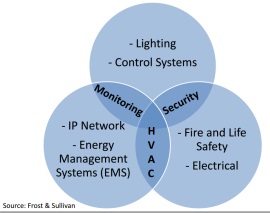
by Aanchal Singh, Frost & Sullivan Research Analyst — In recent years, the importance of facilities management has grown tremendously as new technological advancements, regulations, consumer awareness, and complex building systems have provided new ways to achieve cost savings. The vision of facilities management is moving towards a rather dynamic turn due to external factors such as sustainability and integrated building design along with internal factors such as data acquisition.
With the emergence of the Internet of things (IoT), communication technologies, and connectivity, building owners are considering the potential of embedded intelligence with a common control point to simplify building comfort and operational processes. Recent analysis from Frost & Sullivan indicates that the market for smart building systems is poised for growth. In fact, the research finds that the market earned revenue of $2.5 billion in 2013 and estimates this to reach $4.29 billion in 2018.
Efficient and Cost-effective Energy Consumption and Safety
Monitoring and security comprise one of the main challenges in commercial facilities management. In order to overcome this issue, simplifying system-wide control over energy consumption and security is a great way to help utilize energy efficiently. Hence, the application of integrated systems will prove to be an effective strategy to create efficiency and cost-effectiveness within many facilities and occupants’ spaces.
With this concept of unified structure in buildings, various systems such as fire suppression and detection can be integrated with the HVAC system to control smoke and ventilation. Additionally, building energy management systems (BEMS) can access data from other systems to monitor energy usage and electricity costs. This helps create a connected and interoperable mesh of various technologies and systems.
Converged Networks Streamline Functionality
On the other hand, with the availability of many converged network gateways in the market, systems suppliers are delivering intelligent technologies to buildings as a total solution. With this option, use of an IP network is a key element and helps streamline the functionality of the integrated system through a common wireless gateway. This helps create a seamless connection to real-time web-based data that facility managers can leverage in order to make better decisions. Frost & Sullivan analysis indicates that the $14.7 trillion internet economy and the seamlessness in communication provided by new information technologies have positively influenced the connected building, city and home markets.

New Construction and Retrofits Drive the Market for Integrated Solutions
There are many factors driving the market for integrated solutions. With a rebound in construction activities, new construction, and retrofits in North America and across the globe, we can estimate demand for integrated systems to increase in the next two to three years. According to Frost and Sullivan, since mid-2013, construction activities in both the residential and non-residential sectors have increased by 6 percent in North America. In addition to this the rise in construction activities, the building retrofit market is also increasing in North America. These trends will drive demand for the integration of systems in various facilities and buildings triggered, in part, by new energy efficiency strategies.
However, there can be challenges with the integration of systems in existing or aging buildings. Many of these do not have the ideal infrastructure to accommodate integrated systems, especially with respect to space and wiring. Most of these buildings already have systems installed making cable pathways difficult to locate and track. In these buildings, conventional systems are unable to intelligently communicate and manage large amounts of data. A stronger, more organized plan is a necessity when integrating the systems in existing facilities. These must encompass all facility and business systems and perhaps even the utility grid in the future.
Integrated Systems in Action
An excellent example of systems integration is a large sports and entertainment complex called the Rogers Center situated in Toronto, Ontario. According to the Continental Automated Building Association (CABA), the center’s electricity consumption was exceeding $3 million annually. In order to become more energy efficient, the facilities management team decided to adopt addressable networking technology which offers many more benefits than the conventional technology. The retrofitted addressable networking technology was utilized along with the advanced hardware and software control systems which have the ability to maximize energy efficiency.
As a result, this new technology helped the Rogers Center reach $325,000 in cost-savings annually and provided a higher rate of investment (ROI) over three years. Additionally, intelligent lighting played a major part in achieving energy savings, considering that the complex contains more than 7,000 lighting fixtures. With the retrofits, the complex generated 76 percent savings in lighting energy expenses. This example clearly demonstrates that integrated building or facility systems can carve an ideal environment for multiple layers of functionalities to achieve energy efficiency and cost—effectiveness.
Conclusion
Consequently, more and more facilities can leverage these emerging trends in technology. In doing so, facilities managers can create a more converged and integrated network of systems. This can result in a profound impact on the triple bottom-line approach, efficiency, and cost-saving in facilities.